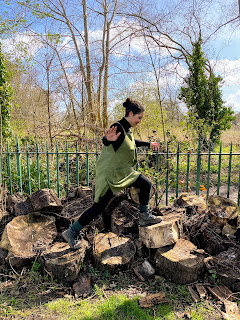Seeing a greenfinch in a patch of no-man’s land near my flat in March 2020 marked a turning point in the way I thought about London wildlife. The last year has dramatically changed my relationship with London, and alongside forming strong relationships with my neighbours, I’ve also become better acquainted with many of the non-human residents of my neighbourhood.
Growing up in a small town in West Sussex, weekends were often spent on country walks with family and friends, learning the names of trees, flowers, birds and insects. Certain walks became favourites, and they marked the passing of the seasons. Snowdrops, wild daffodils and bluebells in the woods during spring. An evening walk on the common to listen to nightjars and look for glow worms at midsummer. Kicking through drifts of golden leaves collecting sweet chestnuts and conkers in autumn. A blustery walk on a beach with geese flying overhead and a flask of hot soup in the car in winter. When I moved to London at eighteen, I still wanted to make these nostalgic pilgrimages back to Sussex every year, creating small family rituals around these much-loved pockets of natural beauty.
I had sought out green space in London, of course, but for years none of the places I walked or picnicked took on the same significance - when you and your friends are renting and always moving, nowhere stays local for very long. During the last decade I’ve only moved twice, and I began to develop a fondness for the Wandle - I found solace walking its scrubby banks when my mind was in turmoil from anxiety and depression, and it began to reward me with glimpses of its riches. I would often text my parents with bird sightings and news. But I still returned to Sussex, treasuring our beloved walks as a balm for my soul, and all-important time with my family.
When the nationwide lockdown was announced last year and I realised that I wouldn’t be marking spring with my usual excursions, my local hour-long walks became more intentional. I took my binoculars, I photographed wild flowers, I made a list of the birds I saw. I was well aware that London wildlife was far more varied than the stereotypical feral pigeons and urban foxes, but I had never thought of a greenfinch as a “London bird”. And yet here they were, in numbers, a fifteen minute walk from my flat.
The Greenfinch Dress is made from three metres of a woollen mix fabric I found dumped near the Wandle back in September. Necessity being the mother of invention, I made the dress I wanted to wear during months of lockdown winter walks. I don’t find trousers warm enough for winter, I prefer to walk in cosy layers - leggings, long socks, leg warmers, a wool skirt. In her book Wild Dress, Kate Fletcher devotes a chapter to walking in skirts. She emphasises the importance of knowing your ideal hem circumference - “a stride and a bit”. Wading through suddenly-flooded parks this winter, leaping over newly-formed streams that threatened to overtop my boots, I took her advice. A stretchy knitted skirt gave me freedom of movement, but was sadly lacking in pockets, and didn’t provide quite enough insulation when I sat down. The loose A-line shape of the dress allows for plenty of movement, as well as the wearing of several layers underneath. The double layer of fabric provides warmth, and a canvas for some mindful embroidery during the darker months.
I’ve marked a year of changing seasons through local walks in London now, and been delighted by the wild beauty I’ve found. Although I’m looking forward to walking further afield, I’ve found so much to interest me close to home, and I’ll continue to appreciate that .










